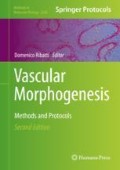Abstract
The capability of forming functional blood vessel networks is critical for the characterization of endothelial cells. In this chapter, we will review a modified in vivo vascular network forming assay by replacing traditional mouse tumor-derived Matrigel with a well-defined collagen–fibrin hydrogel. The assay is reliable and does not require special equipment, surgical procedure, or a skilled person to perform. Moreover, investigators can modify this method on-demand for testing different cell sources, perturbation of gene functions, growth factors, and pharmaceutical molecules, and for the development and investigation of strategies to enhance neovascularization of engineered human tissues and organs.
Access this chapter
Tax calculation will be finalised at checkout
Purchases are for personal use only
References
Kastana P, Zahra FT, Ntenekou D et al (2019) Matrigel plug assay for in vivo evaluation of angiogenesis. Methods Mol Biol 1952:219–232
Benton G, Arnaoutova I, George J et al (2014) Matrigel: from discovery and ECM mimicry to assays and models for cancer research. Adv Drug Deliv Rev 79-80:3–18
Melero-Martin JM, Khan ZA, Picard A et al (2007) In vivo vasculogenic potential of human blood-derived endothelial progenitor cells. Blood 109:4761–4768
Melero-Martin JM, Bischoff J (2008) Chapter 13. An in vivo experimental model for postnatal vasculogenesis. Methods Enzymol 445:303–329
Melero-Martin JM, De Obaldia ME, Kang SY et al (2008) Engineering robust and functional vascular networks in vivo with human adult and cord blood-derived progenitor cells. Circ Res 103:194–202
Traktuev DO, Prater DN, Merfeld-Clauss S et al (2009) Robust functional vascular network formation in vivo by cooperation of adipose progenitor and endothelial cells. Circ Res 104:1410–1420
Au P, Daheron LM, Duda DG et al (2008) Differential in vivo potential of endothelial progenitor cells from human umbilical cord blood and adult peripheral blood to form functional long-lasting vessels. Blood 111:1302–1305
Risau W, Flamme I (1995) Vasculogenesis. Annu Rev Cell Dev Biol 11:73–91
Lin RZ, Moreno-Luna R, Munoz-Hernandez R et al (2013) Human white adipose tissue vasculature contains endothelial colony-forming cells with robust in vivo vasculogenic potential. Angiogenesis 16:735–744
Wang ZZ, Au P, Chen T et al (2007) Endothelial cells derived from human embryonic stem cells form durable blood vessels in vivo. Nat Biotechnol 25:317–318
Neumeyer J, Lin RZ, Wang K et al (2019) Bioengineering hemophilia A-specific microvascular grafts for delivery of full-length factor VIII into the bloodstream. Blood Adv 3:4166–4176
Wang K, Lin RZ, Melero-Martin JM (2019) Bioengineering human vascular networks: trends and directions in endothelial and perivascular cell sources. Cell Mol Life Sci 76:421–439
Costa-Almeida R, Gomez-Lazaro M, Ramalho C et al (2015) Fibroblast-endothelial partners for vascularization strategies in tissue engineering. Tissue Eng Part A 21:1055–1065
Lin RZ, Melero-Martin JM (2012) Fibroblast growth factor-2 facilitates rapid anastomosis formation between bioengineered human vascular networks and living vasculature. Methods 56:440–451
Chen YC, Lin RZ, Qi H et al (2012) Functional human vascular network generated in photocrosslinkable gelatin methacrylate hydrogels. Adv Funct Mater 22:2027–2039
Lin RZ, Chen YC, Moreno-Luna R et al (2013) Transdermal regulation of vascular network bioengineering using a photopolymerizable methacrylated gelatin hydrogel. Biomaterials 34:6785–6796
Lin RZ, Moreno-Luna R, Li D et al (2014) Human endothelial colony-forming cells serve as trophic mediators for mesenchymal stem cell engraftment via paracrine signaling. Proc Natl Acad Sci U S A 111:10137–10142
Allen P, Melero-Martin J, Bischoff J (2011) Type I collagen, fibrin and PuraMatrix matrices provide permissive environments for human endothelial and mesenchymal progenitor cells to form neovascular networks. J Tissue Eng Regen Med 5:e74–e86
Lin RZ, Melero-Martin JM (2011) Bioengineering human microvascular networks in immunodeficient mice. J Vis Exp:e3065
Greenberger S, Boscolo E, Adini I et al (2010) Corticosteroid suppression of VEGF-A in infantile hemangioma-derived stem cells. N Engl J Med 362:1005–1013
Greenberger S, Yuan S, Walsh LA et al (2011) Rapamycin suppresses self-renewal and vasculogenic potential of stem cells isolated from infantile hemangioma. J Invest Dermatol 131:2467–2476
Boscolo E, Limaye N, Huang L et al (2015) Rapamycin improves TIE2-mutated venous malformation in murine model and human subjects. J Clin Invest 125:3491–3504
Acknowledgments
This work was supported by the National Institutes of Health grants R01AR069038 and R01HL128452 to J. M.-M.
Author information
Authors and Affiliations
Corresponding author
Editor information
Editors and Affiliations
Rights and permissions
Copyright information
© 2021 Springer Science+Business Media, LLC, part of Springer Nature
About this protocol
Cite this protocol
Kim, H.D., Lin, RZ., Melero-Martin, J.M. (2021). In Vivo Vascular Network Forming Assay. In: Ribatti, D. (eds) Vascular Morphogenesis. Methods in Molecular Biology, vol 2206. Humana, New York, NY. https://doi.org/10.1007/978-1-0716-0916-3_14
Download citation
DOI: https://doi.org/10.1007/978-1-0716-0916-3_14
Published:
Publisher Name: Humana, New York, NY
Print ISBN: 978-1-0716-0915-6
Online ISBN: 978-1-0716-0916-3
eBook Packages: Springer Protocols

